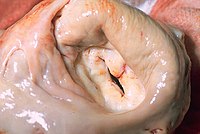
Photo from wikipedia
BACKGROUND For rheumatic mitral stenosis (MS), a multidisciplinary evaluation is mandatory to determine the optimal treatment: medical, percutaneous balloon mitral valvuloplasty (PBMV) or valve surgery. Clinical and imaging evaluations are… Click to show full abstract
BACKGROUND For rheumatic mitral stenosis (MS), a multidisciplinary evaluation is mandatory to determine the optimal treatment: medical, percutaneous balloon mitral valvuloplasty (PBMV) or valve surgery. Clinical and imaging evaluations are essential for procedural risk assessment and outcomes. PBMV interventions are increasingly available in Africa and are feasible options for selected candidates. Enhancing PBMV training/skills transfer across most of African countries is possible. OBJECTIVES The aim of this study was to provide insight into the clinical practice of patients with rheumatic MS evaluated for PBMV in a Tanzanian teaching hospital and to define the role of imaging, and evaluate the heart team and training/skills transfer in PBMV interventions. METHODS From August 2019 to May 2022, 290 patients with rheumatic MS were recruited consecutively in the Tanzania Mitral Stenosis study. In total, 43 (14.8%) patients were initially evaluated for eligibility for PBMV by a heart team. We carried out the clinical assessment, laboratory investigations, transthoracic/oesophageal echocardiography (TTE/TEE) and electrocardiography. RESULTS The median age was 31 years (range 11-68), and two-thirds of the patients were female (four diagnosed during pregnancy). Two patients had symptomatic MS at six and eight years. Nine patients had atrial fibrillation with left atrial thrombus in three, and two were detected by TEE. Nine patients in normal sinus rhythm had spontaneous echo contrast. The mean Wilkins score was 8.6 (range 8-12). With re-evaluation by the local and visiting team, 17 patients were found to have unfavourable characteristics: Bi-commissural calcification (four), ≥ grade 2/4 mitral regurgitation (six), high scores and left atrial thrombus (three), left atrial thrombus (two), and severe pulmonary hypertension (two). Three patients died before the planned PBMV. Eleven patients were on a waiting list. We performed PBMV in 12 patients, with success in 10 of these, and good short-term outcomes [mean pre-PBMV (16.03 ± 5.52 mmHg) and post-PBMV gradients (3.08 ± 0.44 mmHg, p < 0.001)]. There were no complications. CONCLUSIONS PBMV had good outcomes for selected candidates. TEE is mandatory in pre-PBMV screening and for procedural guidance. In our cohort, patients with Wilkins score of up to 11 underwent successful PBMV. We encourage PBMV skills expansion in low- and middle-income countries, concentrating on expertise centres.
Journal Title: Cardiovascular journal of Africa
Year Published: 2023
Link to full text (if available)
Share on Social Media: Sign Up to like & get
recommendations!